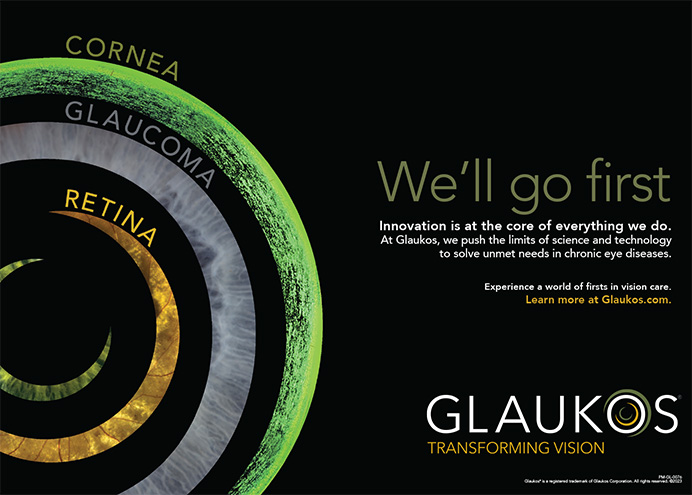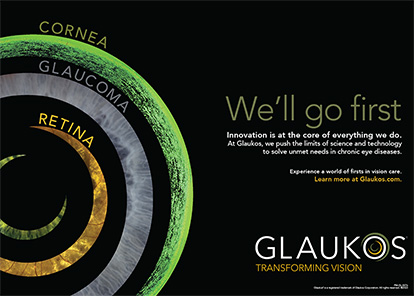Ideally, the process of educating patients about IOL options starts well before they ever set foot in your practice. On the day of the patient's visit, this information is reintroduced at the front desk. It is then reiterated and expanded upon in the back office for approximately 45 minutes. From there, IOL education is reviewed in the lanes for 5 to 15 minutes before the process ends in the back office.
Welcome to the multiple levels of education required to properly inform patients about the benefits of presbyopia-correcting IOLs and the other numerous vision-correction options available today. Without such an intensive approach, many practices are running into obstacles in converting patients from standard to presbyopia-correcting IOLs.
PHYSICIANS' LEARNING CURVE
When presbyopia-correcting lenses first became available, most surgeons simply assumed that brief educational efforts in the lanes would be enough to convince patients of the need to upgrade their cataract or refractive procedure to a premium lens implant. They quickly discovered, however, that far fewer patients were converting to the new lenses than expected.
In addition to encountering an initial lackluster conversion factor, surgeons soon found themselves spending inordinate amounts of "lane time" answering questions, alleviating fears, and explaining higher procedural fees. Surgeons may have been willing to accept this increased time in the lanes had it resulted in a higher percentage of conversions to the premium lenses. Unfortunately, it did not, which is why some surgeons grew less than enthusiastic about promoting the new lenses to patients.
Fortunately, a handful of refractive practices around the country were simultaneously enjoying extremely high patient satisfaction (and conversion rates) with presbyopia-correcting IOLs by employing the multilevel marketing and patient education approach. Unlike conventional cataract practices that were unaccustomed to (and improperly staffed for) conducting balance billing for premium product lines, these successful practices had a much easier time assimilating presbyopia-correcting IOLs into their refractive product lines.
THE MULTILEVEL APPROACH
Physicians who successfully convert patients to premium IOLs discuss the benefits of refractive surgery at every possible stage of a patient's inquiry, starting even before the patient's first examination. These surgeons mail easy-to-read printed information to all potential presbyopes and cataract patients prior to their first visit. Their front-office staff readily repeat this message at the reception desk during patients' initial visits. They distribute additional information at this stage, which is reinforced again in the back office by the technicians.
Successful practices prominently display signage with messages such as "Great news for cataract patients." Countertop displays offer relief to all patients who are "Frustrated with reading glasses and bifocals." Every potential candidate for a presbyopia-correcting IOL knows his options and is motivated to choose premium IOLs before he ever sees the surgeon … thereby dramatically reducing the amount of time the surgeon spends educating him in the lane.
UNDERSTANDING THE PATIENT BASE
Successful refractive surgeons understand the value of educating patients on multiple levels and how this strategy elevates the perceived value of presbyopia-correcting IOLs. They know that it is necessary to identify a patient's chief complaint before he visits the office so that they are prepared for the examination. These surgeons also realize that they can save lane time if the patient initiates the conversation about presbyopia-correcting IOLs by simply saying how hopeful they are of being a candidate for the exciting new lens technology.
Perhaps most importantly, refractive surgeons understand how to help patients overcome their financial hurdles. Because presbyopia-correcting IOLs require higher fees—in some cases, well over $5,000 per eye—refractive surgeons know that they not only have to raise patients' perceived value of these procedures but also must make them affordable. Just as it did for the automobile industry and LASIK industries, 0 financing has come to the rescue of the presbyopia-correcting IOL market. Cataract patients and presbyopes are embracing patient financing with the same enthusiasm as LASIK patients. They recognize the value of interest-free financing and low-entry payment options that can easily be modified to fit their budgets. That's why many of today's successful refractive practices are financing as many as 50 of their presbyopia-correcting IOL procedures.
WILL OTHER PRACTICES FOLLOW?
It is still too early to tell if conventional cataract surgeons (who are not embracing refractive surgery) will take a few chapters out of the refractive marketing handbook. Until the ruling by the Centers for Medicare & Medicaid Services (CMS) gave cataract practices the green light to increase their surgical fees for the first time in more than a decade, there was absolutely no need for Medicare-based cataract surgeons to rethink their approach to cataract surgery.
The CMS decreased reimbursement for cataract surgery every year for the past decade, which made it difficult for practitioners to hire additional staff or engage in external marketing. To help offset a 6 to 8 decrease in revenue, surgeons felt pressure to see more cataract patients … which wasn't possible without spending less time with each patient. Nevertheless, this system worked, because the CMS covered the majority of costs for most patients.
BEFORE YOU ADOPT THESE LENSES
Today, the conversion process to presbyopia-correcting IOLs means seeing fewer patients, spending more time with each one, and hiring a surgical counselor instead of a typical surgical scheduler. The additional time spent with patients delivers the personal touch they seek and allows for more thorough education and informed consent to take place. The addition of a surgical counselor allows your staff to complete the educational process and answer all of a patient's questions and concerns before he considers undergoing presbyopia-correcting IOL implantation.
Overpromising and underdelivering the results of presbyopia-correcting IOLs ensures you will encounter postoperative challenges, to say the least. If you thought you were spending inordinate amounts of time in the lanes with candidates for presbyopia-correcting IOLs preoperatively, wait until you see an unsatisfied postoperative patient who just spent $10,000. Therefore, be certain of the limits of every lens you implant, give patients brutally honest and realistic expectations, operate only on ideal candidates, and educate, educate, educate. There has never been a better time to be a cataract patient, a presbyope, or a cataract/refractive surgeon. Be sure to share that sentiment with your patients.
Michael W. Malley is President and Founder of the Centre for Refractive Marketing (CRM Group), an ophthalmic consulting/advertising agency established in 1988. Mr. Malley may be reached at (713) 839-0202; mike@refractivemarketing.com.


